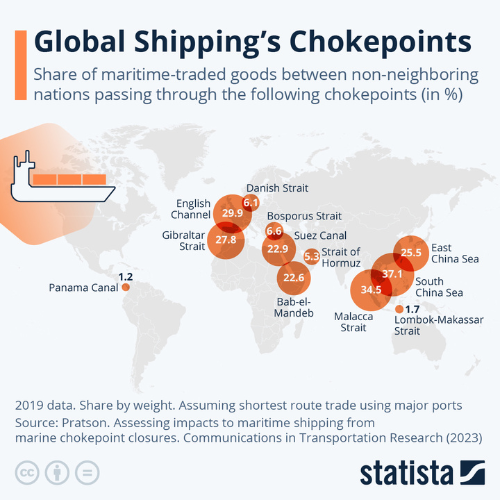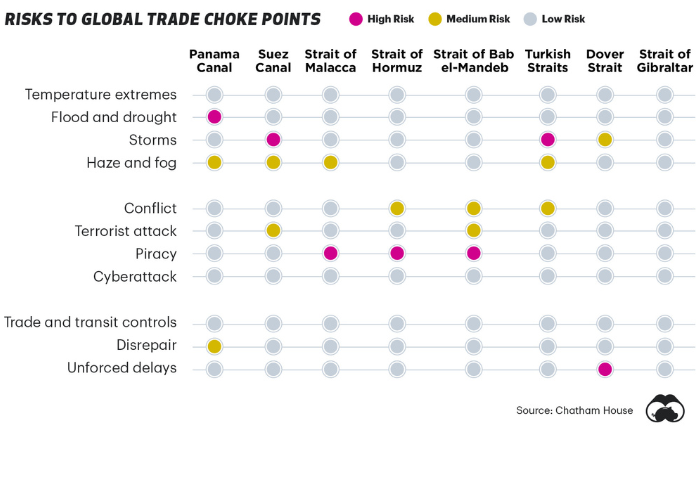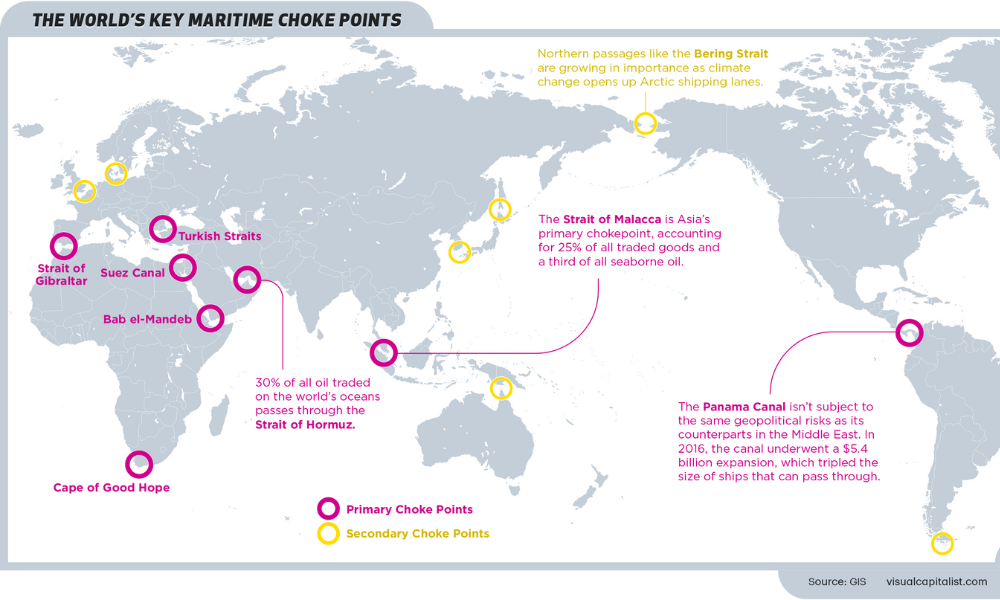Photo credit: visualcapitalist.com
In recent years, numerous incidents have disrupted the world’s most important trade waterways, impacting supply chains across industries and economies.
The upheavals include COVID-19 pandemic lockdowns, the Ever Given getting stuck in the Suez Canal, persistent drought at the Panama Canal, Russia’s blockade of Ukraine’s Black Sea ports and the ongoing attacks on ships in the Red Sea, to name a few.
These narrow maritime passages are critical for global trade, especially for energy and food supplies, and their disruption can have significant, far-reaching economic and systemic consequences. Disruptions at key ocean trade routes can significantly impact the global economy given that 90% of traded goods continue to be shipped by sea, according to the International Maritime Organization.
Here are seven of the most important waterways for global trade:
1. The Suez Canal
The Suez Canal in Egypt connects the Mediterranean with the Red Sea and is a dividing line between Africa and Asia. The canal, which is at the opposite end of the Red Sea and Gulf of Aden's Bab Al Mandeb strait, is the shortest maritime route from Europe to Asia and allows ships to avoid the long trip around South Africa's Cape of Good Hope.
The canal is close to 200km long and sees on average over 20,000 vessel crossings every year.The Suez Canal has long played a strategic role in both trade and geopolitics. In recent months, the canal has been affected by attacks on commercial ships in the Red Sea, causing vessels to divert through the Cape of Good Hope .

2. The Panama Canal
The Panama Canal connects the Atlantic and Pacific Ocean and has been a significant waterway for global trade since its completion in 1914.
The geography and construction of the Panama Canal require locks to lift and lower ships as they make their way across the Isthmus of Panama. It has been expanded over time to help even-larger vessels avoid a long journey around Cape Horn at the tip of South America. The canal connects nearly 2,000 ports in 170 countries and facilitated more than 14,000 transits in 2023.
3. The Malacca Strait
Located between Sumatra Island in Indonesia and the Malay Peninsula, the Malacca Strait interconnects the Indian and Pacific Ocean. It extends from the Andaman Sea through the Strait of Singapore to the South China Sea, and connects many of Asia’s major economies, including Japan, Taiwan, South Korea and India.
Around 94,000 ships pass through the Malacca Strait every year or use its more than 40 ports. Together, the ships carry around 30% of all traded goods globally.
4. The Hormuz Strait
The Hormuz Strait is wedged between Iran and Oman, and links the Persian Gulf with the Gulf of Oman and the Arabian Sea. As the main shipping route for oil from the Middle East, the strait sees a fifth of the world’s oil consumption passing through it daily – around 21 million barrels. It also carries 20% of global liquefied natural gas every year.
Like shipping in the nearby Red Sea, security and geopolitical tensions have been a concern for shipping companies operating in the Hormuz Strait
5. Bab el-Mandeb Strait
It is a narrow strait (about 26km) between the southwestern Arabian Peninsula (Yemen) and East Africa (Eritrea and Djibouti).
It accounted for 8.7% of the global ocean cargo volume in 2023, and 20% of the world's automobiles, 20% of containers, 15% of petroleum products, and 13% of crude oil transported by sea passing through this strait.[1] The Yemeni civil war, which began in 2015, along with Somali piracy cases occurring around the strait and the Gulf of Aden, is one of the key factors threatening the security of the strait

6. Turkish Strait
The Turkish Strait is a maritime passage connecting the Black Sea and the Aegean Sea, comprised of the Bosphorus Strait and the Dardanelles Strait within the Turkic territory, and has been considered a strategic point from ancient times to modern times. In 2023, 3.1% of the world's maritime cargo volume was transported through Turkish Strait.
7. English Channel
The English Channel connects the North Sea to the Atlantic Ocean. It is an essential trade volume connection between Europe, the UK, and North America. Over 500 ships pass this channel every day.
This route reduces transport time by 210 minutes, bringing it down to 90 minutes. The British port of Dover is on the British shore, and the French port of Calais is on the French side. This is due to the large number of vessel movements along this route.

